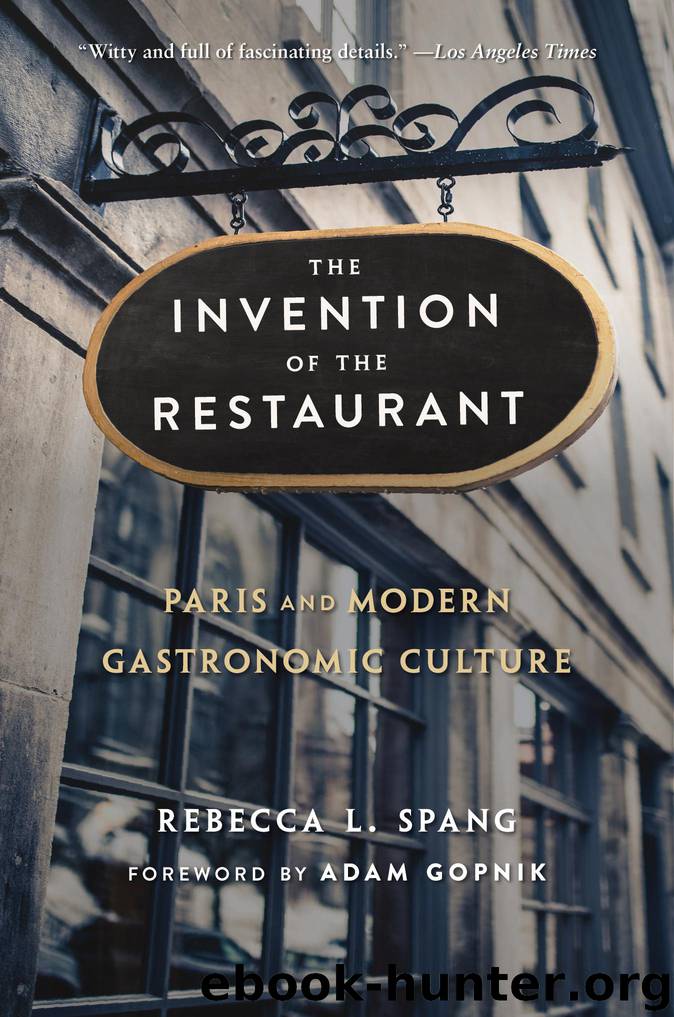The Invention of the Restaurant by Rebecca L. Spang

Author:Rebecca L. Spang
Language: eng
Format: epub
Publisher: Harvard University Press
The Laws of Taste
Taking shape across the decade of Grimod de la Reynière’s dictates and pronouncements, gastronomic discourse regularly reiterated the necessary chasm separating preparation from consumption, kitchen from dining room. “With food, as with the law,” Grimod quoted, “to find it good, you must not see it being made.”72 On this premise, it was not only the sausageman’s stuffing of brains, blood, and ground meat into emptied intestines, but the gastronomer’s savoring of that surprisingly delectable concoction as well, that needed to be concealed from view. Surrounding his decision-making processes with opaque layers of secrecy, Grimod separated the gastronomer’s table from the potentially contaminating influences of the outside world. He honored the seventeen-member “Wednesday Society,” whose midweek meals had shaped “gastronomic jurisprudence” for the past twenty-four years, by dedicating the Almanach’s fourth volume to them, but he also noted that naming the members would violate the anonymity central to the Society’s continued happiness. Since “obscurity” and taste formed the heart of their credo, who was he to compliment them for one while sacrificing the other? Instead of threatening the members’ privacy, he abstained from naming them, and saluted the Society as a whole.73
In a modern regime of set prices and abolished privileges, where anyone’s money was supposedly as good as everybody else’s, the food critic was (and is) a famous figure who nonetheless must ensure that he is treated like an ordinary customer. Dressed sometimes as a modest man of letters, sometimes as an affluent lawyer, and sometimes as a crotchety throwback to the Old Regime, Grimod for all his notoriety claimed to walk the streets of Paris shrouded by a cloak of anonymity.74 Once he became known as the author of the Almanach des gourmands, however, Grimod de la Reynière ate his meals in striking privacy, never again exposing himself to view as he had in the 1783 funereal supper. While he proved as astute a publicist as ever, he sought public attention by slightly different means, striving to deflect attention from his own role in order to refocus it on the expertise he represented.
Grimod might claim that “our itineraries have become for the food trades, what the exhibition on the Champs de Mars is for businessmen and manufacturers,” but the latter was a show in which a year’s worth of French products and inventions were publicly displayed for several weeks.75 These annual industrial fairs (nation-sized precursors of the later universal exhibitions) partook of an Enlightenment logic of publicness and visibility that Grimod’s meandering promenades utterly lacked. For whereas the exhibitions brought goods together in a central location where all might come to see them, the edibles Grimod described were spread across Paris, involving the would-be connoisseur not in a parade-ground review, but in a scavenger hunt. Both were public, but in very different ways: the expositions, where the Ministries of Industry and Agriculture awarded cash prizes and furthered “advances” in all arenas, belonged to Roze de Chantoiseau’s world of improved circulation, but Grimod’s itineraries were part of
Download
This site does not store any files on its server. We only index and link to content provided by other sites. Please contact the content providers to delete copyright contents if any and email us, we'll remove relevant links or contents immediately.
| Culinary Biographies | Essays |
| Food Industry | History |
| Reference |
For the Love of Europe by Rick Steves(3351)
The Sprouting Book by Ann Wigmore(3056)
BraveTart by Stella Parks(2976)
Better Homes and Gardens New Cookbook by Better Homes & Gardens(2958)
The Death of the Heart by Elizabeth Bowen(2908)
Salt, Fat, Acid, Heat: Mastering the Elements of Good Cooking by Nosrat Samin(2661)
Sauces by James Peterson(2594)
Classic by Mary Berry(2504)
Solo Food by Janneke Vreugdenhil(2495)
The Bread Bible by Rose Levy Beranbaum(2477)
Ottolenghi - The Cookbook by Yotam Ottolenghi(2361)
Martha Stewart's Baking Handbook by Martha Stewart(2335)
Kitchen confidential by Anthony Bourdain(2318)
Betty Crocker's Good and Easy Cook Book by Betty Crocker(2283)
Day by Elie Wiesel(2246)
Hot Sauce Nation by Denver Nicks(2108)
The Plant Paradox by Dr. Steven R. Gundry M.D(2047)
My Pantry by Alice Waters(2044)
The Kitchen Counter Cooking School by Kathleen Flinn(2016)
